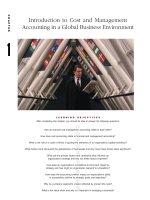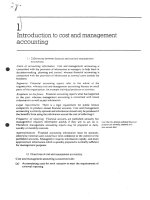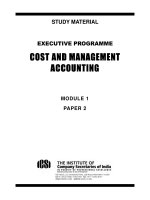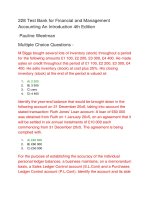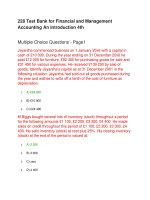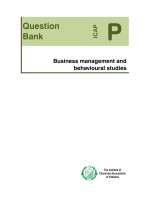CAF8 cost and management accounting question bank ICAP
Bạn đang xem bản rút gọn của tài liệu. Xem và tải ngay bản đầy đủ của tài liệu tại đây (2.89 MB, 228 trang )
ICAP
Question
Bank
P
Cost and management accounting
Second edition published by
Emile Woolf Limited
Bracknell Enterprise & Innovation Hub
Ocean House, 12th Floor, The Ring
Bracknell, Berkshire, RG12 1AX United Kingdom
Email:
www.emilewoolf.com
© Emile Woolf International, January 2015
All rights reserved. No part of this publication may be reproduced, stored in a retrieval
system, or transmitted, in any form or by any means, electronic, mechanical, photocopying,
recording, scanning or otherwise, without the prior permission in writing of Emile Woolf
Publishing Limited, or as expressly permitted by law, or under the terms agreed with the
appropriate reprographics rights organisation.
You must not circulate this book in any other binding or cover and you must impose the
same condition on any acquirer.
Notice
Emile Woolf International has made every effort to ensure that at the time of writing the
contents of this study text are accurate, but neither Emile Woolf International nor its directors
or employees shall be under any liability whatsoever for any inaccurate or misleading
information this work could contain.
© Emile Woolf International
ii
The Institute of Chartered Accountants of Pakistan
Certificate in Accounting and Finance
Cost and management accounting
C
Contents
Page
Question and Answers Index
v
Questions
Section A
Objective test and long-form questions
1
Objective test and long-form answers
83
Answers
Section B
© Emile Woolf International
iii
The Institute of Chartered Accountants of Pakistan
Cost and management accounting
© Emile Woolf International
iv
The Institute of Chartered Accountants of Pakistan
I
Certificate in Accounting and Finance
Cost and management accounting
Index to Objective test and
long-form questions and
answers
Question
page
Answer
page
Chapter 1 - Inventory valuation
1.1
Steel Rods
1
83
1.2
XYZ Limited
2
84
1.3
Mehanti Limited
2
85
Chapter 2 - Inventory management
2.1
Stock items 6786 and 6787
4
87
2.2
Inventory control
4
87
2.3
Alpha Motors (Pvt) Ltd
5
88
2.4
ABC
5
88
2.5
Karachi Limited
6
89
2.6
Moder Distributors Limited
7
90
2.7
Robin Limited
7
90
2.8
Ore Limited
8
91
2.9
Explain
8
92
9
93
Chapter 3 - Accounting for overheads
3.1
© Emile Woolf International
Overhead cost per unit
v
The Institute of Chartered Accountants of Pakistan
Cost and management accounting
Question
page
Answer
page
3.2
Apportionment
9
93
3.3
Service departments
10
94
3.4
Zia Textile Mills
11
95
3.5
Ternary Engineering Limited
12
96
3.6
Production and service
13
97
3.7
RT Limited
13
98
3.8
Ahsan Enterprises
14
99
3.9
Amber Limited
15
100
3.10
Sparrow (Pvt) Limited
16
101
Chapter 4 - Marginal costing and absorption costing
4.1
Differences
17
102
4.2
Marginal and absorption
17
102
4.3
Zulfiqar Limited
18
104
4.4
ATF Limited
19
106
4.5
Mazahir (Pakistan) Limited
19
107
4.6
Silver Limited
20
108
Chapter 5 - Cost flow in production
5.1
Cost ledger
21
109
5.2
Kaat Limited
21
111
5.3
Mirza Limited
23
112
5.4
Quality Limited
24
113
5.5
Sapphire Limited
25
115
Chapter 6 - Job, batch and service costing
6.1
Job 6789
26
118
6.2
Ahmer and company
26
118
Chapter 7 - Process costing
7.1
Process costing: The basic rules
27
120
7.2
Process 1 and process 2
27
122
© Emile Woolf International
vi
The Institute of Chartered Accountants of Pakistan
Index to questions and answers
Question
page
Answer
page
7.3
Equivalent units
28
123
7.4
Yahya Limited
29
124
7.5
Two processes
30
125
7.6
Smart Processing Limited
30
127
7.7
Hornbill Limited
31
129
7.8
Fowl Limited
32
130
7.9
Joint process
33
131
7.10
Binary Ltd
33
132
7.11
Platinum limited
34
133
Chapter 8 - Budgeting
8.1
Budgeted profit and loss account
35
134
8.2
Budgeted profit and loss account 2
35
136
8.3
Budgeted profit and loss account 3
37
137
8.4
Cash requirements
37
138
8.5
Budgeted profit
38
139
8.6
Profit forecast statement
40
141
8.7
Cash budget
41
143
8.8
Regression method
42
146
8.9
Production cost budget
42
146
8.10
Cash budget
43
147
Chapter 9 - Standard costing
9.1
Standard cost – ICA
44
148
9.2
Standard cost - Idle time
44
148
Chapter 10 - Variance analysis
10.1
Reconcile
45
149
10.2
Simple variances
45
150
10.3
Overhead variances
46
152
10.4
Manufacturing cost variance
46
152
© Emile Woolf International
vii
The Institute of Chartered Accountants of Pakistan
Cost and management accounting
Question
page
Answer
page
10.5
Variances and operating statements
47
157
10.6
Volume and expenditure variances
48
158
10.7
Lettuce
49
159
10.8
Moongazer
49
162
10.9
BRK
50
165
10.10
Carat
51
166
10.11
Hexa Limited
52
170
10.12
Excellent Limited
53
171
10.13
Watool Limited
54
174
10.14
ABC Limited
55
176
10.15
Standard cost sheet
55
178
Chapter 11 - Target costing
11.1
Scriba company
56
180
11.2
Target
56
81
Chapter 12 - Relevant costs
12.1
Jimco
58
183
12.2
Materials and relevant costs
58
183
12.3
Printing leaflets
59
184
12.4
JD
59
185
12.5
Product B22
60
186
12.6
Fazal Industries Limited
62
187
12.7
Describe terms
63
188
12.8
Topaz Limited
63
188
12.9
Tychy Limited
64
189
Chapter 13 - Cost-Volume-Profit (CVP) analysis
13.1
Octa Electronics
65
190
13.2
Soft drink company
65
191
13.3
Solvent Limited
66
192
© Emile Woolf International
viii
The Institute of Chartered Accountants of Pakistan
Index to questions and answers
Question
page
Answer
page
Chapter 14 - Decision making techniques
14.1
Limiting factors
67
193
14.2
Shortages
68
194
14.3
Make or buy
69
196
14.4
Condaco
70
198
14.5
Decimal world Limited
70
199
14.6
Three products
71
200
14.7
Areesh Limited
71
201
14.8
Jaseem Limited
72
202
14.9
Bauxite Limited
73
202
14.10
Artery Limited
73
203
Chapter 15 - Introduction to financial instruments
15.1
Sources of finance
75
205
15.2
Direct and indirect investment
75
207
15.3
FI definitions 1
75
208
15.4
FI definitions 2
75
209
Chapter 16 - Time value of money
16.1
DCF and relevant costs
76
210
16.2
Annuities and perpetuities
77
210
16.3
Investment appraisal and inflation
77
211
16.4
DCF exercises
78
212
16.5
Conto Company
78
213
16.6
Baypack Company
79
214
16.7
Larkana Fabrication Limited
79
214
16.8
Badger
80
216
Chapter 17 – Sustainability reporting
17.1
Benefits of sustainability reporting
82
217
17.2
IFAC sustainability framework 2.0
82
218
17.3
Key considerations for professional
accountants
82
218
© Emile Woolf International
ix
The Institute of Chartered Accountants of Pakistan
Cost and management accounting
© Emile Woolf International
x
The Institute of Chartered Accountants of Pakistan
SECTION
Certificate in Accounting and Finance
Cost and management accounting
A
Objective test and
long-form questions
CHAPTER 1 – INVENTORY VALUATION
1.1
STEEL RODS
During the month of February the following transactions in steel rods took place:
1 February
2 February
3 February
5 February
6 February
10 February
12 February
15 February
16 February
20 February
25 February
Purchased
Purchased
Sold
Purchased
Sold
Purchased
Sold
Purchased
Sold
Purchased
Sold
10 tons
3 tons
2 tons
2 tons
3 tons
8 tons
8 tons
2 tons
2 tons
5 tons
7 tons
@ Rs.600 per ton
@ Rs.550 per ton
@ Rs.560 per ton
@ Rs.555 per ton
@ Rs.555 per ton
@ Rs.560 per ton
Required
Calculate the prices to be applied to the issues and the closing balance figures
using:
(a)
FIFO
(6)
(b)
Weighted average.
(8)
(14)
© Emile Woolf International
1
The Institute of Chartered Accountants of Pakistan
Cost and management accounting
1.2
XYZ LIMITED
Q.1 XYZ Limited manufactures four products. The related data for the year ended
December 31, 20X3 is given below:
A
Opening inventory
- Units
- Cost (Rs.)
- NRV (Rs.)
- Production in units
Costs of goods produced (Rs.)
Variable selling costs (Rs.)
Closing inventory (units)
Damaged units included in closing
inventory
300
B
Unit cost of purchase from market (Rs.)
Selling price per unit (Rs.)
10.00
Unit cost to repair damaged units (Rs.)
3.00
D
10,000
15,000
20,000
25,000
70,000
120,000
180,000
310,000
75,000
110,000
180,000
300,000
50,000
60,000
75,000
100,000
400,000
600,000
60,000
80,000
90,000
100,000
5,000
10,000
15,000
24,000
600
800
Weighted
Average
Inventory valuation method in use
C
10.50
825,000 1,200,000
1,500
Weighted
Average
FIFO
FIFO
11.00
11.50
13.00
12.00
12.00
12.50
2.00
2.50
3.50
The company estimates that selling expenses will increase by 10% in January 20X4.
Required
Compute the amount of closing inventory that should be reported in the statement of
financial position as on December 31, 20X3.
(15)
1.3
MEHANTI LIMITED
Mehanti Limited (ML) produces and markets a single product Wee. Two chemicals
Bee and Gee are used in the ratio of 60:40 for producing 1 litre of Wee. ML follows
perpetual inventory system and uses weighted average method for inventory
valuation. The purchase and issue of Bee and Gee for May 20X3, are as follows:
Date
Bee
Gee
Receipt
Litre
Issue
Rate
Litre
Receipt
Issue
Litre
Rate
Litre
450
110
-
02-05-20X3
-
-
05-05-20X3
-
-
560
-
-
650
09-05-20X3
-
-
300
-
-
300
12-05-20X3
420
52
-
700
115
-
18-05-20X3
-
-
250
-
-
150
24-05-20X3
500
55
-
250
124
-
31-05-20X3
-
-
500
-
-
450
© Emile Woolf International
2
The Institute of Chartered Accountants of Pakistan
Question bank: Objective test and long-form questions
Following further information is also available:
(i)
Opening inventory of Bee and Gee was 1,000 litres at the rate of Rs. 50
per litre and 500 litres at the rate of Rs. 115 per litre respectively.
(ii)
The physical inventories of Bee and Gee were 535 litres and 140 litres
respectively. The stock check was conducted on 01 June and 31 May 20X3 for
Bee and Gee respectively.
(iii)
Due to contamination, 95 litres of Bee and 105 litres of Gee were excluded
from the stock check. Their net realisable values were Rs 20 and Rs. 50 per
litre respectively.
(iv)
250 litres of Bee which was received on 01 June 20X3 and 95 litres of Gee
which was issued on 31 May 20X3 after the physical count were included in
the physical inventory.
(v)
150 litres of chemical Bee was held by ML on behalf of a customer,
whereas 100 litres of chemical Gee was held by one of the suppliers on ML’s
behalf.
(vi)
100 litres of Bee and 200 litres of Gee were returned from the production
process on 31 May and 01 June 20X3 respectively.
(vii) 240 litres of chemical Bee purchased on 12th May and 150 litres of chemical
Gee purchased on 24th May 20X3 were inadvertently recorded as 420 litres
and 250 litres respectively.
Required
(a)
Reconcile the physical inventory balances with the balances as per book.
(b)
Determine the cost of closing inventory of chemical Bee and Gee. Also
compute the cost of contaminated materials as on 31 May 20X3.
© Emile Woolf International
3
(15)
The Institute of Chartered Accountants of Pakistan
Cost and management accounting
CHAPTER 2 - INVENTORY MANAGEMENT
2.1
STOCK ITEMS 6786 AND 6787
(a)
A company uses 15,000 units of stock item 6786 each year. The item has a
purchase cost of Rs.4 per unit. The cost of placing an order for re-supply is
Rs.220. The annual holding cost of one unit of the item is 10% of its purchase
cost.
Required
(b)
(i)
What is the economic order quantity for item 6786, to the nearest unit?
(ii)
What would be the effect of an increase in the annual holding cost per
unit on (1) the EOQ and (2) total annual ordering costs?
Data relating to stores item 6787 are as follows.
Daily use:
Lead time for re-supply:
Reorder quantity:
300 units
5 – 20 days
10,000 units
Required
What should be the reorder level for this stock item, to avoid the possibility of
inventory-outs?
2.2
INVENTORY CONTROL
Entity G uses 105 units of an item of inventory every week. These cost Rs.150 per
unit. They are stored in special storage units and the variable costs of holding the
item is Rs.4 per unit each year plus 2% of the inventory’s cost.
Required
(a)
If placing an order for this item of material costs Rs.390 for each order, what is
the optimum order quantity to minimise annual costs? Assume that there are
52 weeks in each year.
(b)
Suppose that the supplier offers a discount of 1% on the purchase price for
order sizes of 2,000 units or more. What will be the order size to minimise total
annual costs?
© Emile Woolf International
4
The Institute of Chartered Accountants of Pakistan
Question bank: Objective test and long-form questions
2.3
ALPHA MOTORS (PVT.) LTD
Alpha Motors (Pvt.) Ltd. uses a special gasket for its automobiles which is
purchased from a local manufacturer. The following information has been made
available by the procurement department:
Annual requirement (no. of gaskets)
Cost per gasket (Rs.)
Ordering cost per order (Rs.)
Carrying cost per gasket (Rs.)
162,000
1,000
27,000
300
The gaskets are used evenly throughout the year. The lead time for an order is
normally 11 days but it can take as much as 15 days. The delivery time and the
probability of their occurrence are given below:
Delivery time (in days)
11
12
13
14
15
Probability of occurrence
68%
12%
10%
6%
4%
Required
(a)
Compute the Economic Order Quantity (EOQ) and the total Ordering Costs
based on EOQ.
(04)
(b) What would be the safety stock and re-order level if the company is willing to
take:
a 20% risk of being out of stock?
a 10% risk of being out of stock?
(08)
Note: Assume a 360 day year.
2.4
ABC
ABC has recently established a new unit in Multan. Its planning for the first
year of operation depicts the following:
(i)
(ii)
(iii)
(iv)
(v)
(vi)
Cash sales
600,000 units
Credit sales
1,200,000 units
Ending inventory
Equivalent to 15 days sales
Number of working days in the year
300
Expected purchase price
Rs. 450 per unit
Manufacturer offers 2% discount on purchase of 500 units or more as bulk
quantity discount. The company intends to avail this discount.
(vii) Carrying costs include:
Financial cost of investment in inventory @ 16% per annum.
Godown rent of Rs. 10,000 per month.
(viii) Ordering costs are Rs. 300 per order.
Required
Compute the Economic Order Quantity (EOQ) and the estimated carrying costs and
ordering costs for the first year of operation.
(10)
© Emile Woolf International
5
The Institute of Chartered Accountants of Pakistan
Cost and management accounting
2.5
KARACHI LIMITED
(a)
Karachi Limited is a large retailer of sports goods. The company buys footballs
from a supplier in Sialkot. Karachi Limited uses its own truck to pick the
footballs from Sialkot. The truck capacity is 2,000 footballs per trip and
the company has been getting a full load of footballs at each trip, making 12
trips each year.
Recently the supplier revised its prices and offered quantity discount as under:
Quantity
2,000
3,000
4,000
6,000
8,000
Unit price (Rs.)
400
390
380
370
360
Other related data is given below:
All the purchases are required to be made in lots of 1,000 footballs.
The cost of making one trip is Rs. 15,000. The company has the option
to hire a third party for transportation which would charge Rs. 9 per
football.
The cost of placing an order is Rs. 2,000.
The carrying cost of one football for one year is Rs. 80.
Required
(b)
(i)
Work out the most economical option.
(ii)
Compute the annual savings in case the company revises its
policy in accordance with the computation in (i) above.
(10)
Briefly describe:
(i)
Stock out costs
(ii)
Lead time
(iii)
Reorder point
(iv)
Safety stock
© Emile Woolf International
(04)
6
The Institute of Chartered Accountants of Pakistan
Question bank: Objective test and long-form questions
2.6
MODERN DISTRIBUTORS LIMITED
Modern Distributors Limited (MDL) is a distributor of CALTIN which is used in
various industries and its demand is evenly distributed throughout the year.
The related information is as follows:
(i)
Annual demand in the country is 240,000 tons whereas MDL’s share is 32.5%
thereof.
(ii)
The average sale price is Rs. 22,125 per ton whereas the profit margin is 25%
of cost.
(iii)
The annual variable costs associated with purchasing department are
expected to be Rs. 4,224,000 during the current year. It has been estimated
that 10% of the variable costs relate to purchasing of CALTIN.
(iv)
Presently, MDL follows the policy of purchasing 6,500 tons at a time.
(v)
Carrying cost is estimated at 1% of cost of material.
(vi)
MDL maintains a buffer stock of 2,000 tons.
Required
Compute the amount of savings that can be achieved if MDL adopts the policy of
placing orders based on Economic Order Quantity.
(15)
2.7
ROBIN LIMITED
Robin Limited (RL) imports a high value component for its manufacturing process.
Following data, relating to the component, has been extracted from RL’s records for
the last twelve months:
Maximum usage in a month
Minimum usage in a month
Average usage in a month
Maximum lead time
Minimum lead time
Re-order quantity
300 units
200 units
225 units
6 months
2 months
750 units
Required
Calculate the average stock level for the component.
© Emile Woolf International
7
(05)
The Institute of Chartered Accountants of Pakistan
Cost and management accounting
2.8
ORE LIMITED
Ore Limited (OL) is a manufacturer of sports bicycles. The company buys tyres from
a local vendor.
Following data, relating to a pair of tyres, has been extracted from OL’s records:
Cost (per unit)
Storage cost based on average inventory
Insurance cost based on average inventory
Store keeper’s salary (included in absorbed overheads)
Cost incurred on final quality check at the time of delivery
Rs.
80
60
8
10
Other relevant details are as follows:
(i)
The purchase price is Rs. 900 per pair.
(ii)
The annual demand for tyres is 200,000 pairs.
(iii)
The ordering cost per order is Rs. 8,000.
(iv)
The delivery cost per order is Rs. 3,000.
(v)
OL’s rate of return on investment in inventory is 15%.
(vi)
Recently the vendor has offered a quantity discount of 3% on orders of a
minimum of 5,000 pairs.
Required
Evaluate whether OL should avail the quantity discount from the vendor.
2.9
(10)
EXPLAIN
Explain briefly what is meant by the term inventory control. Describe, giving reasons,
the method of stock valuation which should be used in times of fluctuating prices.
(05)
© Emile Woolf International
8
The Institute of Chartered Accountants of Pakistan
Question bank: Objective test and long-form questions
CHAPTER 3 - ACCOUNTING FOR OVERHEADS
3.1
OVERHEAD COST PER UNIT
A company makes two products, Product X and Product Y. Each product is
processed through two cost centres, CC1 and CC2. The following budgeted data is
available.
Allocated and apportioned overheads
(All overheads are fixed costs.)
Direct labour hours per unit
Product X
Product Y
CC1
CC2
Rs.126,000
Rs.180,000
1.5
1.2
2.0
2.6
The budgeted production is 12,000 units of Product X and 10,000 units of Product Y.
Fixed overheads are absorbed into costs on a direct labour hour basis.
Required
Calculate the budgeted total fixed overhead cost per unit for Product X and for
Product Y.
3.2
APPORTIONMENT
A production centre has three production departments, A, B and C.
Budgeted production overhead costs for the next period are as follows:
Rs.
Factory rent
Equipment depreciation
Insurance
Heating and lighting
Indirect materials:
Department A
Department B
Department C
Indirect labour:
Department A
Department B
Department C
60,000
80,000
20,000
18,000
7,000
6,600
9,400
40,000
27,000
20,000
Insurance costs relate mainly to health and safety insurance, and will be
apportioned on the basis of the number of employees in each department. Heating
and lighting costs will be apportioned on the basis of volume.
Other relevant information is as follows:
Total
Direct labour hours
Number of employees
Floor area (square metres)
Cost of equipment
(Rs.000s)
Volume (cubic metres)
© Emile Woolf International
Department
A
Department
B
Department
C
18,000
50
1,200
1,000
8,000
20
300
200
6,000
16
400
600
4,000
14
500
200
18,000
8,000
6,000
4,000
9
The Institute of Chartered Accountants of Pakistan
Cost and management accounting
Required
3.3
(a)
Calculate the overhead costs for each production department.
(b)
Calculate an overhead absorption rate for the period for each department,
assuming that a separate direct labour hour absorption rate is used for each
department.
(c)
Calculate an overhead absorption rate for the period, assuming that a single
factory-wide direct labour hour absorption rate is used.
SERVICE DEPARTMENTS
In a factory with four production departments and two service departments, the
operating costs for the month of October were as shown below.
Rs.
Production Department 1
Production Department 2
Production Department 3
Service departments
Canteen
Boiler house
700,000
300,000
400,000
78,000
100,000
1,578,000
The costs of running the canteen are apportioned to each department on the basis
of the estimated use of the canteen by employees in each department.
The costs of the boiler house are apportioned on the basis of the estimated
consumption of power by each department.
The service departments’ costs are therefore apportioned as follows:
Production Department 1
Production Department 2
Production Department 3
Service departments
Canteen
Boiler house
Canteen
Boiler
house
%
40
20
30
%
30
30
20
10
20
-
Required
Prepare a statement showing the allocation of costs to the production departments
using:
(a)
the repeated distribution method
(b)
the simultaneous equations method.
© Emile Woolf International
10
The Institute of Chartered Accountants of Pakistan
Question bank: Objective test and long-form questions
3.4
ZIA TEXTILE MILLS
(a)
Explain the treatment of under-absorbed and over-absorbed factory
overheads. Give three reasons for under-absorbed / over absorbed factory
overheads.
(06)
(b)
On December 1, 20X3 Zia Textile Mills Limited purchased a new cutting
machine for Rs. 1,300,000 to augment the capacity of five existing machines
in the Cutting Department. The new machine has an estimated life of 10
years after which its scrap value is estimated at Rs. 100,000. It is the policy
of the company to charge depreciation on straight line basis.
The new machine will be available to Cutting Department with effect from
February 1, 20X4. It is budgeted that the machine will work for 2,600
hours in 20X4. The budgeted hours include:
80 hours for setting up the machine; and
120 hours for maintenance.
The related expenses, for the year 20X4 have been estimated as under:
(i)
Electricity used by the machine during the production will be 10 units
per hour @ Rs. 8.50 per unit.
(ii)
Cost of maintenance will be Rs. 25,000 per month.
(iii)
The machine requires replacement of a part at the end of every month
which will cost Rs. 10,000 on each replacement.
(iv)
A machine operator will be employed at Rs. 9,000 per month.
(v)
It is estimated that on installation of the machine, other departmental
overheads will increase by Rs. 5,000 per month.
Cutting Department uses a single rate for the recovery of running costs of the
machines. It has been budgeted that other five machines will work for 12,500
hours during the year 20X4, including 900 hours for maintenance. Presently,
the Cutting Department is charging Rs. 390 per productive hour for recovery
of running cost of the existing machines.
Required
Compute the revised machine hour rate which the Cutting Department
should use during the year 20X4.
(08)
© Emile Woolf International
11
The Institute of Chartered Accountants of Pakistan
Cost and management accounting
3.5
TERNARY ENGINEERING LIMITED
Ternary Engineering Limited produces front and rear fenders for a motorcycle
manufacturer.
It has three production departments and two service departments. Overheads are
allocated on the basis of direct labour hours. The management is considering
changing the basis of overhead allocation from a single overhead absorption rate to
departmental overhead rate. The estimated annual overheads for the five
departments are as under:
Production Departments
Fabrication Phosphate
Rs.000
Rs.000
Painting
Rs.000
Direct materials
6,750
300
750
Direct labour
1,200
385
480
Indirect material
Service
Inspection Maintenance
Rs.000
Rs.000
30
75
Other variable overheads
200
70
100
30
15
Fixed overheads
480
65
115
150
210
Total departmental expenses
8,630
820
1,445
210
300
Maximum production capacity
20,000
25,000
30,000
Direct labour hours
24,000
9,600
12,000
9,000
1,000
1,200
630
273
147
1,000
500
1,500
Machine hours
Use of service departments:
Maintenance - Labour
hours
Inspection - Inspection
hours
Required
(a)
Compute the single overhead absorption rate for the next year. (06)
(b)
Compute the departmental overhead absorption rates in accordance with the
following:
The Maintenance Department costs are allocated to the production
department on the basis of labour hours.
The Inspection Department costs are allocated on the basis of inspection
hours.
The Fabrication Department overhead absorption rate is based on
machine hours whereas the overhead rates for Phosphate and Painting
Departments is based on direct labour hours.
(10)
© Emile Woolf International
12
The Institute of Chartered Accountants of Pakistan
Question bank: Objective test and long-form questions
3.6
PRODUCTION AND SERVICE
The expenses of the production and service departments of a company for a
year are as follows:
Department
Production department - A
-B
Expenses before
distribution of service
department costs
Rs. ‘000
500
400
Service department – X
-Y
100
60
Service provided (%age)
Dept. X
Dept. Y
50
30
40
50
20
10
-
Required
Allocate the service departments expenses to production departments by:
3.7
Repeated distribution method
Simultaneous equation method
(13)
RT LIMITED
Following information has been extracted from the records of RT Limited for August
20X3:
Budgeted machine hours
Actual machine hours
Budgeted labour hours
Actual labour hours
Budgeted material cost (Rs.
‘000) material cost (Rs. ‘000)
Actual
Budgeted overheads (Rs. ‘000)
Actual overheads (Rs. ‘000)
Services provided by S-1
Services provided by S-2
Basis of overhead application
P-1
60,000
60,500
50,000
55,000
50,000
50,000
1,200
1,250
20%
30%
Machine
hours
Departments
Production
P-2
P-3
100,000
120,000
110,000
100,000
200,000
75,000
190,000
75,000
40,000
3,000
42,000
3,200
2,000
2,250
2,000
1,800
30%
40%
40%
20%
75% of
Labour
hours Material cost
Service
S-1 S-2
600
500
10%
700
750
10%
-
Required
(a)
Allocate costs of service departments using repeated distribution method.
(b)
Compute department wise over / under applied overheads.
© Emile Woolf International
13
(12)
The Institute of Chartered Accountants of Pakistan
Cost and management accounting
3.8
AHSAN ENTERPRISES
Ahsan Enterprises (AE) produces three products Alpha, Beta and Gamma. The
management has some reservations on the method of costing. Consequently, the
cost accountant has reviewed the records and gathered the following information:
(i)
The costs incurred during the latest quarter were as follows:
Rupees
240,000
1,680,000
600,000
360,000
468,000
400,000
2,800,000
1,560,000
240,000
60,000
1,800,000
1,200,000
Direct material
Direct labour
Indirect wages – machine maintenance
– stores
– quality control
– cleaning and related services
Fuel and power
Depreciation on plant, machinery and building
Insurance on plant and machinery
Insurance on building
Stores, spares and supplies consumed
Rent, rates and taxes
(ii)
The production report for the previous quarter depicted the following
information:
Alpha
Beta
Gamma
(iii)
Production
(units)
12,000
20,000
45,000
Direct labour Machine hours
Inspection
hours per unit
per unit
hours per unit
20.00
6.00
2.0
5.00
8.00
3.0
4.00
10.00
4.0
Other relevant details are as follows:
Factory space utilization
Cost of machinery (Rs. in thousands)
Stores consumption (Rs. in thousands)
No. of units inspected
Alpha
40%
6,000
720
600
Beta
35%
4,000
270
400
Gamma
25%
3,000
810
1,350
The rate of depreciation for plant and machinery is 10% per annum.
Required
(a)
Determine the factory overhead cost per unit for products Alpha, Beta and
Gamma by using single factory overhead rate based on direct labour hours.
(b)
Recalculate the factory overhead cost per unit, for each product, by
allocating individual expenses on the basis of specific utilisation of related
facilities.
(13)
© Emile Woolf International
14
The Institute of Chartered Accountants of Pakistan
Question bank: Objective test and long-form questions
3.9
AMBER LIMITED
Amber Limited (AL) manufactures a single product. Following information pertaining
to the year 20X4 has been extracted from the records of the company’s three
production departments.
Department
Budgeted
Actual
A
B
C
A
B
C
Material
Rs. in million
80
150
120
80
150
120
Labour
Machine
Hours
200,000
400,000
500,000
125,000
250,000
350,000
220,000
340,000
530,000
120,000
240,000
320,000
AL produced 3.57 million units during the period. The budgeted labour rate per
hour is Rs. 120. The overheads for department-A is budgeted at Rs. 5.0 million, for
department-B at 15% of labour cost and for department-C at 5% of prime cost of
the respective departments. Actual overheads for department A, B and C are Rs.
5.35 million, Rs. 8.90 million and Rs. 7.45 million respectively.
Overheads are allocated on the following basis:
Department-A
Machine hours
Department-B
Labour hours
Department-C
Percentage of Prime cost
There was no beginning or ending inventory in any of the production departments.
Required
(a)
Budgeted overhead application rate for each department.
(05)
(b)
The total and departmental actual cost for each unit of product.
(08)
(c)
The over or under applied overhead for each department.
(03)
© Emile Woolf International
15
The Institute of Chartered Accountants of Pakistan

